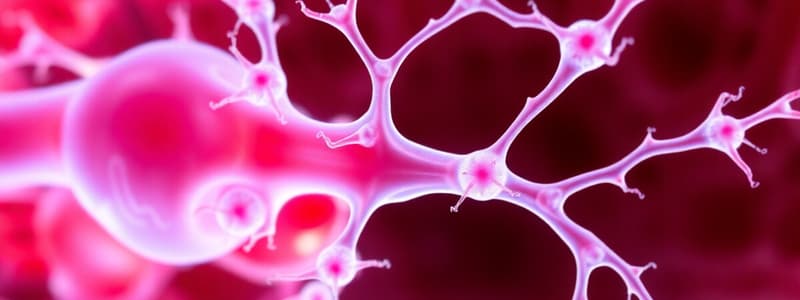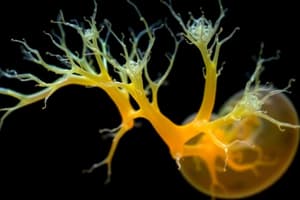Podcast
Questions and Answers
Cranial neural crest cells give rise to neurons, melanocytes, and connective tissue.
Cranial neural crest cells give rise to neurons, melanocytes, and connective tissue.
True (A)
Cardiac neural crest cells only contribute to the development of cartilage.
Cardiac neural crest cells only contribute to the development of cartilage.
False (B)
Trunk neural crest cells are responsible for producing adrenal medulla.
Trunk neural crest cells are responsible for producing adrenal medulla.
True (A)
Vagal/sacral neural crest cells are primarily associated with sympathetic ganglia.
Vagal/sacral neural crest cells are primarily associated with sympathetic ganglia.
Neural crest cells exhibit contact inhibition of locomotion during migration.
Neural crest cells exhibit contact inhibition of locomotion during migration.
Lineage tracing of trunk neural crest cells indicates they are unipotent stem cells.
Lineage tracing of trunk neural crest cells indicates they are unipotent stem cells.
The gene regulatory network for neural crest development includes paracrine factors and transcription factors.
The gene regulatory network for neural crest development includes paracrine factors and transcription factors.
Pharyngeal pouches are ectodermal derivatives contributing to glandular structures.
Pharyngeal pouches are ectodermal derivatives contributing to glandular structures.
Cranial neural crest cell migration occurs exclusively in the mammalian head.
Cranial neural crest cell migration occurs exclusively in the mammalian head.
The process of collective migration helps neural crest cells avoid mixing during their movement.
The process of collective migration helps neural crest cells avoid mixing during their movement.
The 'Chase and Run' model for cell migration is specifically guided by PLACODES.
The 'Chase and Run' model for cell migration is specifically guided by PLACODES.
Cranial neural crest cells play no significant role in the development of the anterior region of the brain.
Cranial neural crest cells play no significant role in the development of the anterior region of the brain.
Ephrin proteins are involved in segmental restriction of neural crest cells and motor neurons.
Ephrin proteins are involved in segmental restriction of neural crest cells and motor neurons.
Cells bind more efficiently to regions with high EPHRIN expression.
Cells bind more efficiently to regions with high EPHRIN expression.
The piebald mutation is an example of an autosomal recessive trait.
The piebald mutation is an example of an autosomal recessive trait.
Neurogenic placodes are capable of developing into neurons.
Neurogenic placodes are capable of developing into neurons.
Neural crest cell migration occurs only within the embryonic brain.
Neural crest cell migration occurs only within the embryonic brain.
Melanoblast migration can be influenced by different mutations.
Melanoblast migration can be influenced by different mutations.
Xenopus, Mouse, and Zebrafish are all considered inducers in lens formation.
Xenopus, Mouse, and Zebrafish are all considered inducers in lens formation.
Pax6 is a transcription factor that does not influence lens development.
Pax6 is a transcription factor that does not influence lens development.
The injection of Mouse Pax6 mRNA into Drosophila does not produce any ectopic structures.
The injection of Mouse Pax6 mRNA into Drosophila does not produce any ectopic structures.
The term 'induction' refers to the process where tissues interact to initiate or direct the development of specific structures.
The term 'induction' refers to the process where tissues interact to initiate or direct the development of specific structures.
Otx2 is solely associated with retinal development.
Otx2 is solely associated with retinal development.
Flashcards
Optic Vesicle Location
Optic Vesicle Location
Located in the embryonic head and anterior trunk region.
Induction (biology)
Induction (biology)
One tissue influencing the development of a nearby tissue.
Pax6 function
Pax6 function
A transcription factor regulating lens formation.
Mouse Pax6 in Drosophila
Mouse Pax6 in Drosophila
Signup and view all the flashcards
Inducer (biology)
Inducer (biology)
Signup and view all the flashcards
Neural crest cell migration
Neural crest cell migration
Signup and view all the flashcards
Neural crest cell derivatives
Neural crest cell derivatives
Signup and view all the flashcards
Cranial neural crest
Cranial neural crest
Signup and view all the flashcards
Lineage tracing
Lineage tracing
Signup and view all the flashcards
Multipotent stem cells
Multipotent stem cells
Signup and view all the flashcards
Contact inhibition
Contact inhibition
Signup and view all the flashcards
Pharyngeal pouches
Pharyngeal pouches
Signup and view all the flashcards
Gene regulatory network
Gene regulatory network
Signup and view all the flashcards
Paracrine factors
Paracrine factors
Signup and view all the flashcards
Collective Migration
Collective Migration
Signup and view all the flashcards
Chemotaxis in cells
Chemotaxis in cells
Signup and view all the flashcards
Placodes
Placodes
Signup and view all the flashcards
Trunk neural crest
Trunk neural crest
Signup and view all the flashcards
Ephrin proteins
Ephrin proteins
Signup and view all the flashcards
Dorsolateral pathway
Dorsolateral pathway
Signup and view all the flashcards
Piebald mutation (autosomal dominant)
Piebald mutation (autosomal dominant)
Signup and view all the flashcards
Neurogenic placodes
Neurogenic placodes
Signup and view all the flashcards
Study Notes
Neural Crest Cell Migration
- Neural crest cells migrate from the neural folds during embryonic development.
- Part 1 image shows a cross-section of an embryo highlighting neural crest cells.
- Part 2 image is a scanning electron micrograph of neural crest cells.
- Part 3 image is a diagram illustrating the process of neural crest cell migration in a developing embryo.
- Notochord is the supporting structure
- Neural plate boundary separates neural from nonneural ectoderm.
- Premigratory neural crest cells form within the neural fold.
- Delaminating neural crest cells move away from the neural tube.
- Migratory neural crest cells move away from the neural folds.
Derivatives of the Neural Crest
- Neural crest cells differentiate into a diverse range of cell types and tissues.
- Table details various derivatives and their corresponding cell types.
- Peripheral nervous system (PNS) components like neurons, ganglia, and Schwann cells.
- Other cells, such as adrenal medulla cells and calcitonin-secreting cells.
- Pigment cells, cartilage, bones, and connective tissues.
Regions of the Chick Neural Crest
- Figure 15.2 illustrates regions of the chick neural crest.
- Diagrams show different regions like midbrain, forebrain, hindbrain, vagal crest, trunk crest, cardiac crest, pharyngeal arches, dorsal root ganglia, and adrenal gland.
- Information about different locations of neural crest cells.
Multipotent Stem Cells
- Figure 15.3 in the text illustrates lineage tracing of trunk neural crest cells in mice.
- Results indicate these cells are multipotent stem cells.
- This is based on the fact that they could develop into multiple different cell types during the study.
- Different derivatives of trunk neural crest are shown.
Neural Crest Lineage Segregation
- Figure 15.4 illustrates a model of neural crest lineage segregation and heterogeneity.
- Key cellular processes associated with the development of different neural crest-derived cells.
- This involves specific cell lineage specifiers, lineage precursors, and different cell types like cartilage/bone, Schwann cells, and melanocytes.
Specification of Neural Crest Cells
- Figure 15.5 diagrams the specification of neural crest cells.
- Wnt and BMP signaling pathways guide the specification of neural crest cells.
- These interact with other cell types such as placodal ectoderm to form different tissues.
Gene Regulatory Network
- Figure 15.6 and its simplified version (Figure 15.12) show the network that regulates neural crest development.
- These networks involve various transcription factors and genes involved in the process.
- The diagrams show the interrelation between different genes and their effects on cell types like neurons, melanocytes, and chondrocytes during neural crest development.
Neural Crest Delamination and Migration
- Figure 15.9 demonstrates neural crest delamination and migration.
- Cellular processes like contact inhibition, delamination, and directed growth drive the migration.
- Proteins like cadherins, RhoA, Rac1, and Snails drive these cellular processes.
Contact Inhibition of Locomotion
- Figure 15.11 illustrates contact inhibition during neural crest cell migration.
- This inhibition is mediated by proteins like RhoA, Rac1, and cadherins.
Cranial Neural Crest Migration
- Figure 15.18 shows cranial neural crest cell migration from Parts 1, 2, 3, and 4.
- These figures depict the stages of migration in the mammalian head.
- Part 1 contains an image of a developing embryo.
- Part 2 shows specific locations of the migrating cells.
- Part 3 and Part 4 provide further visualizations of developing process.
- Pharyngeal pouches are noted as important structures formed by endoderm.
Chemotactic Cell Migration
- Figure 15.19 illustrates chemotactic cell migration, specifically in the chase-and-run model.
- Chemorepellents/attractors guide cell migration.
- Cells respond to signals that initiate cell movement.
Cranial Neural Crest Cells
- Figure 15.20 shows cranial neural crest cells in the developing mice.
- Images illustrate markers for neural crest cell-derived tissues.
Cranial Neural Crest and Brain Growth
- Figure 15.21 demonstrates the role of cranial neural crest in brain growth.
- Loss of neural crest results in no anterior brain development.
- Neural crest loss stops the growth of the anterior part of the brain.
Neural Crest Cell Migration in Trunk
- Figure 15.13 shows neural crest cell migration in the trunk in the chick embryo.
- Migration pathways along different planes (Dorsolateral and ventral pathway).
Segmental Restriction of Neural Crest Cells
- Figure 15.13 illustrates segmental restriction during neural crest cell and motor neuron development.
- Cells migrate and are restricted based on ephrin proteins.
Induction
- Figure 3.13 describes induction in relation to lens development.
- Optic vesicle induction results in the formation of the lens.
Studying That Suits You
Use AI to generate personalized quizzes and flashcards to suit your learning preferences.




